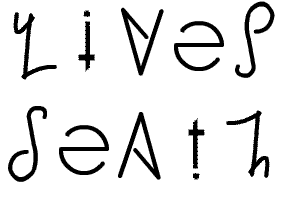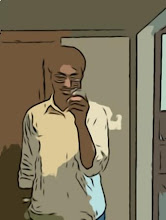Friday, October 3, 2008

This picture is an ambigram, an image which can be viewed in more than one way depending on how you perceive it. The thing about this sort of image, in particular, is that it manages to convince you visually that you're looking at two completely contradictory views at the exact same time. What does this tell you about perception, and the way our brain processes conflicting stimuli? Can you see it as both images simultaneously, or merely as one, then the other, alternating based on how you squint or tip your head?
Labels: Attractive Ambigrams, Optical Illusions
Sunday, March 23, 2008
I had previously posted on ambigrams.This post contains two ambigrams which I missed out on my previous post.
Do you see human face or some other word?
Is this Chinese language???
See the image after 90 degree rotation!
Labels: Attractive Ambigrams, Fun with english
Wednesday, October 24, 2007

I am not an expert in ambigrams....i just know what they are....
 An ambigram is a graphical figure that spells out a word not only in its form as presented, but also in another direction or orientation. The text can also consist of a few words, and the the text spelled out in the other direction or orientation is often the same, but can also be a different text.
An ambigram is a graphical figure that spells out a word not only in its form as presented, but also in another direction or orientation. The text can also consist of a few words, and the the text spelled out in the other direction or orientation is often the same, but can also be a different text.1.Rotational
A design that presents several instances of words when rotated through a fixed angle. This is usually 180 degrees, but rotational ambigrams of other angles exist, for example 90 or 45 degrees. The word spelled out from the alternative direction(s) is often the same, but may be a different word to the initially presented form. A simple example is the lower-case abbreviation for "Down", dn, which looks like the lower-case word up when rotated 180 degrees.
 2.Mirror
2.Mirror
A design that can be read when reflected in a mirror, usually as the same word or phrase both ways. Ambigrams that form different words when viewed in the mirror are also known as glass door ambigrams, because they can be printed on a glass door to be read differently when entering or exiting.

3.Figure-ground
A design in which the spaces between the letters of one word form another word

5.Fractal
A version of space-filling ambigrams where the tiled word branches from itself and then shrinks in a self-similar manner, forming a fractal. See fractal of the word TREE as an animated example.

6.3-dimensional
A design where an object is presented that will appear to read several letters or words when viewed from different angles.

7.Perceptual shift
A design with no symmetry but can be read as two different words depending on how the curves of the letters are interpreted.

A natural ambigram is a word that possesses one or more of the above symmetries when written in its natural state, requiring no typographic styling. For example, the words "dollop" and "suns" are natural rotational ambigrams. The word "bud" forms a natural mirror ambigram when reflected over a vertical axis. The words "CHOICE" and "OXIDE", in all capitals, form a natural mirror ambigram when reflected over a horizontal axis. The word "TOOTH", in all capitals, forms a natural mirror ambigram when its letters are stacked vertically and reflected over a vertical axis.

After this book's publication,awareness on ambigrams has increased.
Hope you find the ambigrams as interesting as I found them...
But beware!!!!once you start designing anagrams you become addicted to them.....
Labels: Attractive Ambigrams, Fun with english


